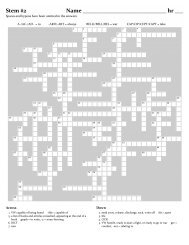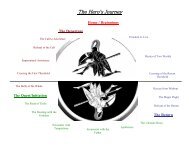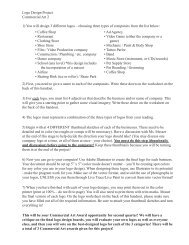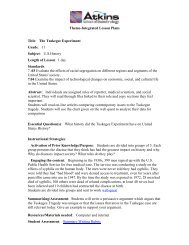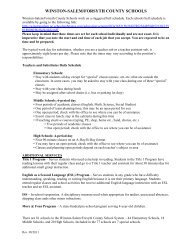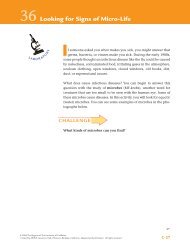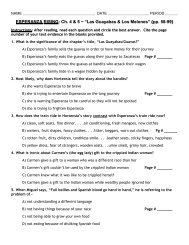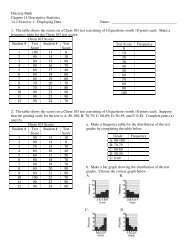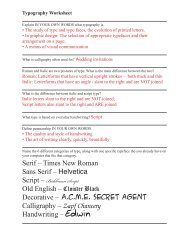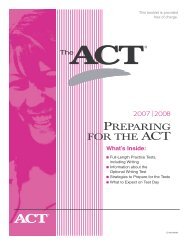Activity 21 • Inside a Pump
Activity 21 • Inside a Pump
Activity 21 • Inside a Pump
You also want an ePaper? Increase the reach of your titles
YUMPU automatically turns print PDFs into web optimized ePapers that Google loves.
<strong>21</strong> <strong>Inside</strong> a <strong>Pump</strong><br />
L A B O R ATO R Y<br />
You know that your blood transports oxygen and carbon dioxide<br />
from one part of your body to another. Your heart is the<br />
pump that keeps your blood moving. Your heart pumps a lot like a<br />
mechanical pump. You will find out more about the structure and<br />
function of your heart by using a mechanical pump as a model.<br />
CHALLENGE<br />
What type of pump is better for pumping water What does this<br />
tell you about the structure of your heart<br />
MATERIALS<br />
For the class<br />
4 siphon bulbs with tubing<br />
For each group of four students<br />
1 pressure bulb<br />
2 45-cm (18-inch) lengths of clear plastic tubing<br />
2 plastic bins (or buckets)<br />
supply of water<br />
SAFETY<br />
Do not attempt to use your mouth to start a pump. During this activity,<br />
water may spill on the floor, so walk carefully.<br />
PROCEDURE<br />
1. Fill one of the bins 3 ⁄4 full of water. (Your teacher may have already<br />
done this.)<br />
2. Connect two pieces of plastic tubing to the pressure bulb, one on<br />
each end.<br />
© 2006 The Regents of The University of California.<br />
Created by SEPUP, Lawrence Hall of Science, Berkeley, California. Adapted with permission. All rights reserved.<br />
➢<br />
B-57
<strong>Activity</strong> <strong>21</strong> • <strong>Inside</strong> a <strong>Pump</strong><br />
Figure 1: The <strong>Pump</strong> Set-Up<br />
3. Place one end of the tubing in the container of water and the other<br />
in the empty container, as shown in Figure 1.<br />
4. Use your pump (pressure bulb) to transfer the water from one container<br />
to the other. (You may have to hold the bulb at or below the<br />
level of the water to get it started. Or you can squeeze the bulb and<br />
place your finger over the open end of the tubing while releasing<br />
the bulb to allow water to flow into the bulb.)<br />
5. Borrow a siphon bulb from your teacher and try to create a pump<br />
that can transfer water from one container to the other.<br />
6. Record how you made one or both pumps work. You can draw<br />
pictures to show what you did.<br />
7. Try to figure out how the pressure bulb works. Hint: You can<br />
remove the tubing, shake the bulb, and listen to both ends as you<br />
squeeze air through the bulb.<br />
8. Watch your teacher demonstrate how a siphon bulb works.<br />
B-58<br />
© 2006 The Regents of The University of California.<br />
Created by SEPUP, Lawrence Hall of Science, Berkeley, California. Adapted with permission. All rights reserved.
<strong>Inside</strong> a <strong>Pump</strong> • <strong>Activity</strong> <strong>21</strong><br />
ANALYSIS<br />
1. If you cut lengthwise through each bulb, the outer walls of the<br />
bulbs will look like the diagrams below. These are called lengthwise<br />
cross-sections. A cross-section gives a view inside a sliced object.<br />
Pressure bulb<br />
Siphon bulb<br />
a. What do you think is inside each bulb Draw a cross-section of<br />
both the siphon bulb and the pressure bulb, as shown above.<br />
Complete the cross-section by drawing and labeling what you<br />
think is inside each bulb.<br />
b. On your drawings of the bulb cross-sections, add arrows showing<br />
which way water flows inside the bulb.<br />
c. What made one bulb work better than the other<br />
2. Which type of bulb is better at pumping water Why<br />
3. Your heart pumps blood around your body. Would you expect it to<br />
work more like the siphon bulb or the pressure bulb Explain.<br />
© 2006 The Regents of The University of California.<br />
Created by SEPUP, Lawrence Hall of Science, Berkeley, California. Adapted with permission. All rights reserved.<br />
B-59



